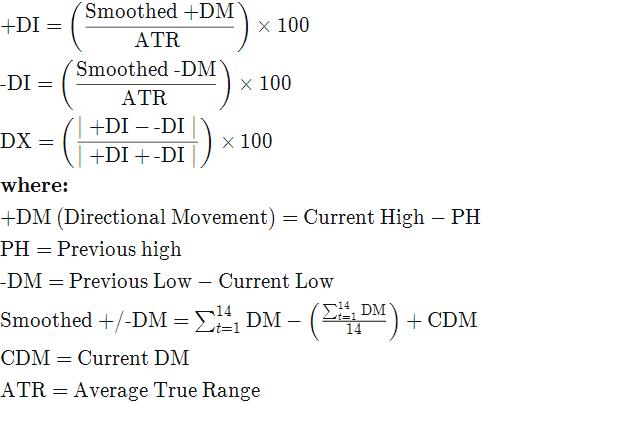Indice de mouvement directionnel (DMI)
Qu’est-ce que l’indice de mouvement directionnel (DMI)?
L’indice de mouvement directionnel (DMI) est un indicateur développé par J. Welles Wilder en 1978 qui identifie dans quelle direction le prix d’un actif évolue. L’indicateur le fait en comparant les hauts et les bas antérieurs et en traçant deux lignes: une ligne de mouvement directionnelle positive (+ DI) et une ligne de mouvement directionnelle négative (-DI). Une troisième ligne facultative, appelée indice directionnel moyen (ADX), peut également être utilisée pour évaluer la force de la tendance haussière ou baissière.
Lorsque + DI est supérieur à -DI, il y a plus de pression à la hausse que de pression à la baisse sur le prix. Inversement, si -DI est supérieur à + DI, alors il y a plus de pression à la baisse sur le prix. Cet indicateur peut aider les traders à évaluer la direction de la tendance. Les croisements entre les lignes sont également parfois utilisés comme signaux commerciaux pour acheter ou vendre.
Points clés à retenir
- L’indice de mouvement directionnel (DMI) est un indicateur technique qui mesure à la fois la force et la direction d’un mouvement de prix et vise à réduire les faux signaux.
- Le DMI utilise deux indicateurs standard, un négatif (-DM) et un positif (+ DN), en conjonction avec un troisième, l’indice directionnel moyen (ADX), qui est non directionnel mais montre une dynamique.
- Plus l’écart entre les deux lignes principales est grand, plus la tendance des prix est forte. Si + DI est bien au-dessus de -DI, la tendance des prix est fortement à la hausse. Si -DI est bien au-dessus de + DI, alors la tendance des prix est fortement à la baisse.
- ADX mesure la force de la tendance, à la hausse ou à la baisse; une lecture au-dessus de 25 indique une forte tendance.
Les formules de l’indice de mouvement directionnel (DMI) sont

Calculating the Directional Movement Index
- Calculate +DM, -DM, and the true range (TR) for each period. Typically 14 periods are used.
- +DM is the current high – previous high.
- -DM is the previous low – current low.
- Use +DM when the current high – previous high is greater than the previous low – current low. Use -DM when the previous low – current low is greater than the current high – previous high.
- The TR is the greater of the current high – current low, the current high – previous close, or the current low – previous close.
- Smooth the 14-period averages of +DM, -DM, and the TR. Below is the formula for TR. Insert the -DM and +DM values to calculate the smoothed averages of those as well.
- First 14TR = Sum of first 14 TR readings.
- Next 14TR value = First 14TR – (Prior 14TR/14) + Current TR
- Next, divide the smoothed +DM value by the smoothed average true range (ATR) value to get +DI. Multiply by 100.
- Divide the smoothed -DM value by the smoothed TR value to get -DI. Multiply by 100.
- The optional directional index (DX) is +DI minus -DI, divided by the sum of +DI and -DI (all absolute values). Multiply by 100.
- The average directional movement index (ADX) is a smoothed average of DX, and is another indicator that can be added to the DMI. To get the ADX, continue to calculate DX values for at least 14 periods. Then, smooth the results to get ADX.
What Does the Directional Movement Index Tell You
The DMI is primarily used to help assess trend direction and provide trade signals.
Crossovers are the main trade signals. A long trade is taken when the +DI crosses above the -DI and an uptrend could be underway. Meanwhile, a sell signal occurs when the +DI instead crosses below the -DI. In such cases, a short trade may be initiated because a downtrend might be underway.
While this method may produce some good signals, it will also produce some bad ones since a trend may not necessarily develop after entry.
The indicator can also be used as a trend or trade confirmation tool. If the +DI is well above -DI, the trend has strength on the upside, and this would help confirm current long trades or new long trade signals based on other entry methods. Conversely, if -DI is well above +DI, this confirms the strong downtrend or short positions.
The Directional Movement Index vs. the Aroon Indicator
The DMI indicator is composed of two lines, with an optional third line. The Aroon indicator also has two lines. The two indicators both show positive and negative movement, helping to identify trend direction.
The calculations are different, though, so crossovers on each of the indicators will occur at different times.
Limitations of the Directional Movement Index
The DMI is part of a larger system called the average directional movement index (ADX). The trend direction of DMI can be incorporated with the strength readings of the ADX. Readings above 20 on the ADX mean the price is trending strongly. Whether using ADX or not, the indicator is still prone to producing lots of false signals.
Notably, +DI and -DI readings and crossovers are based on historical prices and don’t necessarily reflect what will happen in the future. A crossover can occur, but the price may not respond, resulting in a losing trade.
The lines may also crisscross, resulting in multiple signals but no trend in the price. This can be somewhat avoided by only taking trades in the larger trend direction based on long-term price charts, or incorporating ADX readings to help isolate strong trends.